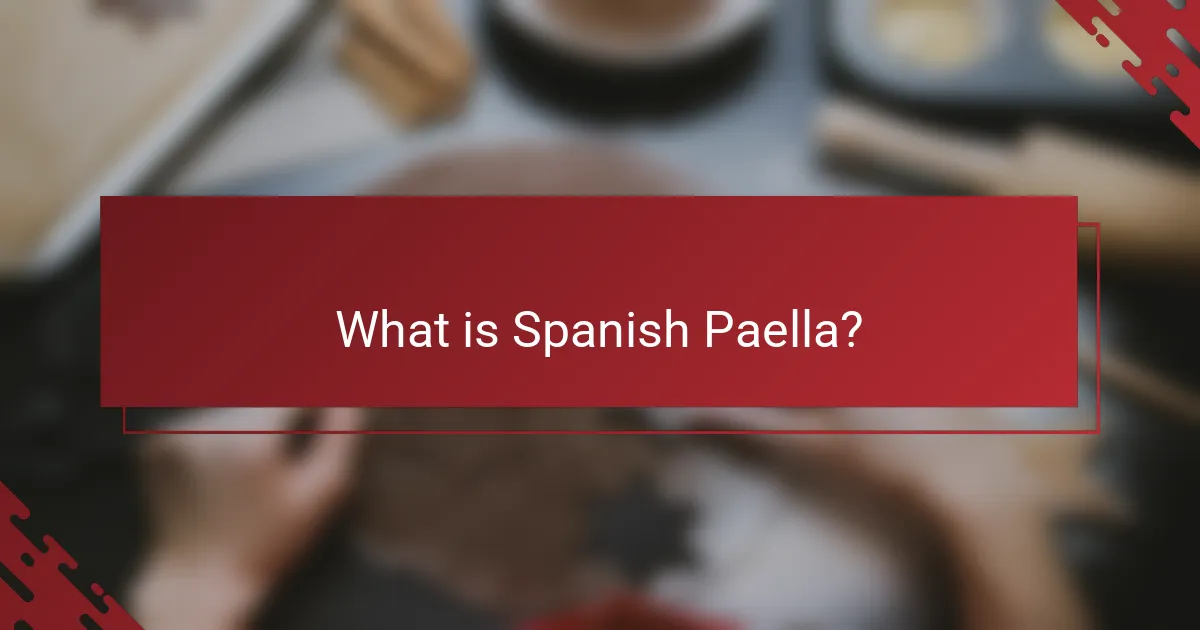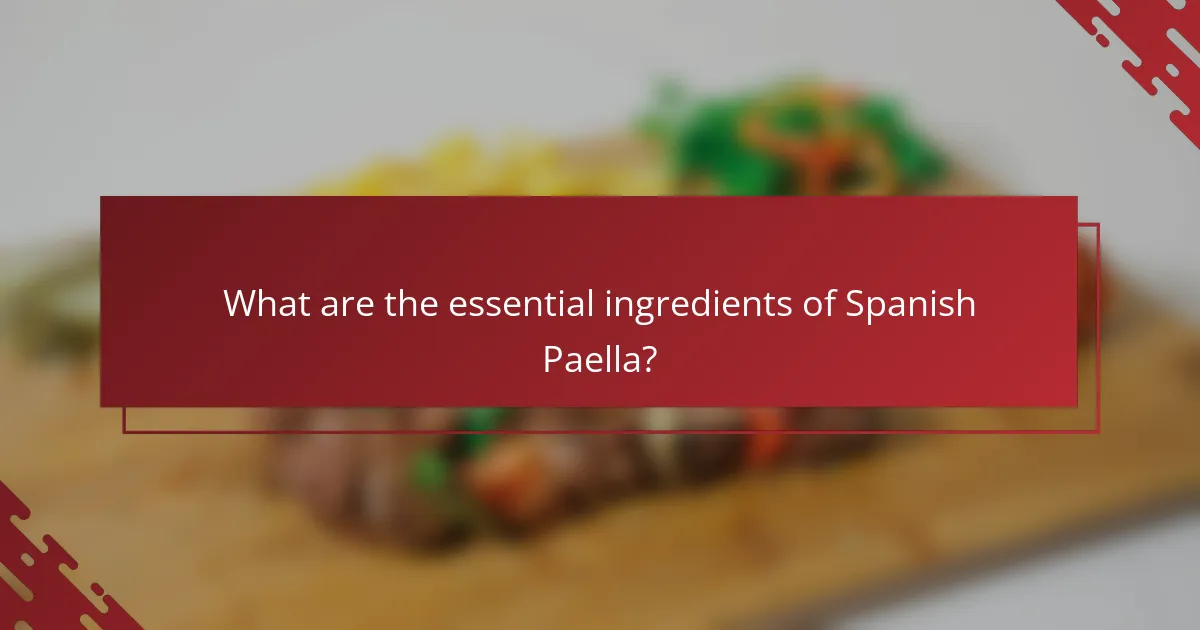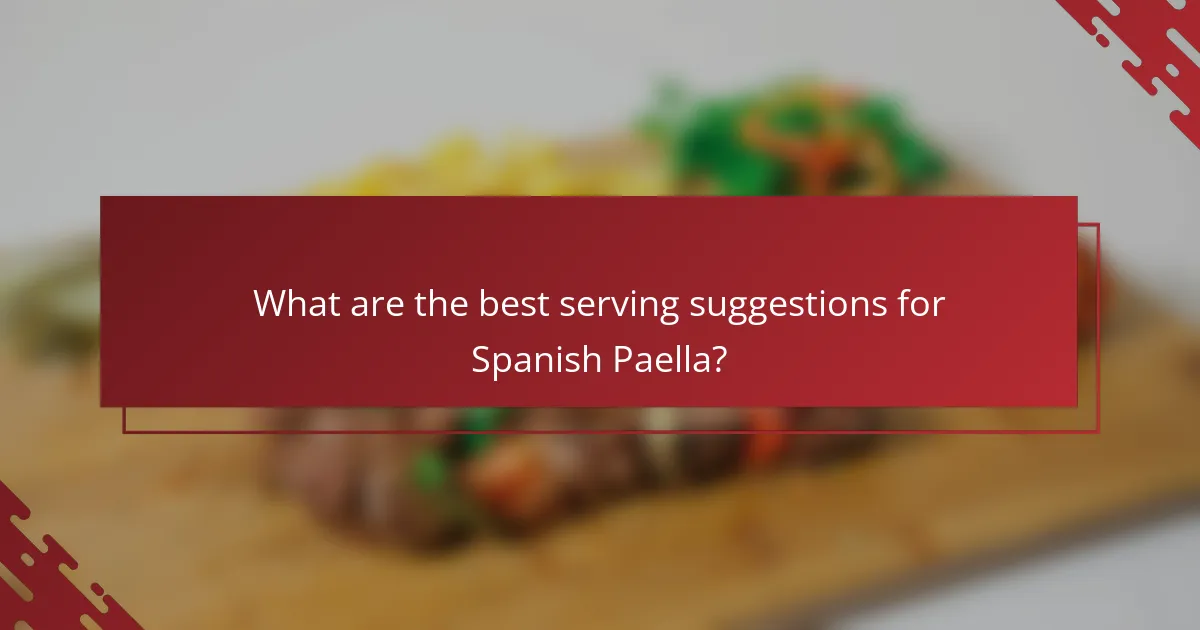Spanish Paella is a traditional rice dish originating from Valencia, Spain, characterized by its distinct yellow color from saffron and a variety of proteins, including chicken, rabbit, and seafood. The dish is prepared in a wide, shallow pan over an open flame, incorporating essential ingredients such as short-grain Bomba rice, olive oil, and a mix of vegetables and spices. With historical roots dating back to the mid-19th century, Paella has become a global symbol of Spanish cuisine, often served at gatherings and celebrations. Suggestions for enhancing the dining experience include serving Paella with lemon wedges, a fresh salad, crusty bread, and a glass of white wine, along with alioli for dipping.

What is Spanish Paella?
Spanish Paella is a traditional rice dish originating from Valencia, Spain. It typically includes saffron, which gives it a distinct yellow color. The dish is known for its combination of various proteins, such as chicken, rabbit, and seafood. Paella is cooked in a wide, shallow pan over an open flame. The rice is often flavored with vegetables, garlic, and spices. Historically, it dates back to the mid-19th century. Paella has become a symbol of Spanish cuisine worldwide. It is commonly served during gatherings and celebrations.
How did Spanish Paella originate?
Spanish Paella originated in the Valencia region of Spain. It began as a rural dish made by farmers and laborers. They cooked rice over an open fire with available ingredients. Traditional ingredients included rabbit, snails, and vegetables. The dish evolved with the introduction of seafood along the coast. In the mid-19th century, Paella became popular beyond Valencia. It is now recognized as a symbol of Spanish cuisine worldwide. The name “paella” comes from the Latin word “patella,” meaning pan.
What historical influences shaped the development of Paella?
Paella developed through various historical influences, particularly from the agricultural practices and cultural exchanges in Valencia. The introduction of rice cultivation by the Moors in the 8th century significantly contributed to its foundation. Additionally, the use of saffron, brought from the Middle East, became a defining characteristic of the dish. The incorporation of local seafood and vegetables reflects the Mediterranean diet and regional availability. The dish evolved further in the 19th century as it gained popularity beyond Valencia, leading to various regional adaptations. The traditional cooking method over an open fire also stems from historical practices in rural Spain. These influences collectively shaped paella into the iconic dish recognized today.
How has Paella evolved over the years?
Paella has evolved significantly over the years, adapting to regional tastes and available ingredients. Originally, it was a humble dish made by farmers and laborers in Valencia, using rice, vegetables, and whatever meat was on hand. Over time, seafood became a popular addition, especially in coastal areas. The introduction of saffron as a key ingredient enhanced its flavor and color. In the 20th century, paella gained international recognition, leading to variations that include chicken, rabbit, and even vegetarian options. Today, it is celebrated worldwide, often served in restaurants and at festive gatherings. The dish’s evolution reflects cultural exchanges and the globalization of cuisine.
What are the key characteristics of Spanish Paella?
Spanish Paella is a traditional rice dish originating from Valencia. It typically features short-grain rice, which absorbs flavors well. Saffron is a key ingredient, providing the distinctive yellow color and unique flavor. Paella often includes a variety of proteins, such as chicken, rabbit, and seafood. Vegetables like green beans and tomatoes are common additions. The dish is cooked in a wide, shallow pan called a paellera. Cooking techniques emphasize layering flavors and achieving a crispy bottom layer known as socarrat. Traditionally, paella is enjoyed as a communal dish, served directly from the pan.
What defines the traditional cooking method of Paella?
The traditional cooking method of Paella is defined by its use of a wide, shallow pan called a “paellera.” This pan allows for even cooking and promotes the development of socarrat, the crispy bottom layer of rice. The method involves sautéing ingredients such as saffron, vegetables, and proteins before adding rice and broth. Authentic Paella is typically cooked over an open flame, enhancing its flavor. The dish is often prepared outdoors, reflecting its communal nature. Traditional recipes emphasize local ingredients, especially seafood and chicken, depending on the region. This cooking method has roots in Valencia, Spain, dating back to the mid-19th century. The emphasis on fresh, local produce is a hallmark of traditional Paella preparation.
How does the presentation of Paella contribute to its identity?
The presentation of Paella significantly contributes to its identity by showcasing its cultural heritage and regional variations. Traditionally, Paella is served in a wide, shallow pan that allows for even cooking and promotes a communal dining experience. The vibrant colors of saffron, vegetables, and seafood create a visually appealing dish that reflects the Mediterranean landscape. This presentation style emphasizes the dish’s roots in Valencia, where it originated, and highlights local ingredients. Additionally, the communal aspect of sharing Paella from a single pan fosters social interaction, reinforcing its identity as a festive meal. The choice of garnishes, such as lemon wedges and fresh herbs, enhances the dish’s visual appeal and flavor profile, further solidifying its cultural significance.

What are the essential ingredients of Spanish Paella?
The essential ingredients of Spanish Paella include rice, saffron, olive oil, and various proteins. Rice is the primary component, typically using a short-grain variety like Bomba. Saffron adds a distinctive flavor and color to the dish. Olive oil is used for sautéing the ingredients. Proteins can vary but often include chicken, rabbit, and seafood. Vegetables such as green beans and tomatoes are also common. The combination of these ingredients creates the traditional flavor profile of Paella.
What are the main components of a traditional Paella?
A traditional Paella consists of rice, saffron, vegetables, and proteins. The rice used is typically short-grain, which absorbs flavors well. Saffron is essential for its distinct color and taste. Common vegetables include green beans, tomatoes, and bell peppers. Proteins can vary but often include chicken, rabbit, and seafood. The combination of these components creates the signature dish of Valencia, Spain. This dish has historical roots dating back to the mid-19th century, emphasizing its cultural significance.
What types of rice are commonly used in Paella?
The types of rice commonly used in Paella are Bomba, Calasparra, and Arborio. Bomba rice is a short-grain variety that absorbs liquid well and maintains its shape. Calasparra rice, also short-grain, is grown in the Valencia region and is known for its high absorption capacity. Arborio rice, typically used in risotto, can also be used in Paella for its creamy texture. These rice varieties are preferred for their ability to absorb flavors while remaining firm, making them ideal for this traditional dish.
Which proteins are typically included in Paella recipes?
Paella recipes typically include proteins such as chicken, rabbit, and various seafood. Chicken is a common choice, often used for its flavor and texture. Rabbit can add a unique taste that complements the dish. Seafood options frequently include shrimp, mussels, and clams, enhancing the dish’s maritime essence. These proteins are integral to traditional Valencian paella, which is recognized for its diverse ingredients. The combination of these proteins contributes to the rich and varied flavor profile of paella.
How do different regions influence the ingredients used in Paella?
Different regions influence the ingredients used in Paella by incorporating local produce and seafood. In Valencia, the birthplace of Paella, traditional ingredients include rabbit, chicken, and green beans. Coastal regions, like Alicante, often use seafood such as shrimp and mussels. The Basque Country favors fish and unique spices, reflecting its maritime culture. Each area’s climate and agricultural practices shape ingredient availability. For example, Mediterranean regions provide an abundance of rice, saffron, and vegetables. This regional variation creates distinct flavors and textures in Paella, showcasing local culinary traditions.
What variations exist between Valencian and seafood Paella?
Valencian Paella typically includes rabbit, chicken, and green beans, while seafood Paella contains a variety of seafood such as shrimp, mussels, and fish. Valencian Paella is traditionally made with short-grain rice and flavored with saffron. Seafood Paella often uses a fish stock instead of water for added flavor. The cooking technique differs as well; Valencian Paella is cooked over an open flame, while seafood Paella may be prepared on a stovetop. Additionally, Valencian Paella is often garnished with lemon, while seafood Paella may include parsley. These variations highlight regional preferences and available ingredients, showcasing the diversity within Spanish cuisine.
How do local ingredients affect the flavor profiles of Paella?
Local ingredients significantly enhance the flavor profiles of Paella. They bring freshness and authenticity to the dish. For instance, locally sourced seafood adds a briny depth. Regional vegetables contribute unique sweetness and texture. Local spices, like saffron from Valencia, provide distinct aromas. The use of local olive oil enriches the overall mouthfeel. Historical practices emphasize the importance of regional sourcing. Traditional recipes often highlight local produce, reflecting the area’s culinary heritage. These elements combine to create a more vibrant and authentic Paella experience.

What are the best serving suggestions for Spanish Paella?
Serve Spanish Paella with lemon wedges for added brightness. The acidity enhances the dish’s flavors. Pair it with a fresh salad, such as a simple mixed greens salad. This adds a refreshing contrast to the rich paella. Serve crusty bread on the side to soak up the delicious broth. A glass of white wine, like Albariño, complements the seafood flavors. For a traditional touch, include alioli, a garlic mayonnaise, for dipping. These suggestions enhance the overall dining experience with Spanish Paella.
How should Paella be presented at the table?
Paella should be presented at the table in its traditional pan. This method retains the dish’s authenticity and enhances its visual appeal. The pan, known as a “paellera,” is typically round and shallow. It allows for even cooking and showcases the vibrant colors of the ingredients.
Serve the paella directly from the pan to create a communal dining experience. Guests can help themselves, which encourages sharing and interaction. Garnish the dish with fresh herbs like parsley or lemon wedges for added color and flavor.
Traditionally, paella is served with a side of alioli, a garlic mayonnaise that complements the dish. This presentation style reflects the cultural significance of paella in Spanish cuisine. It highlights the dish’s communal nature and enhances the dining experience.
What accompaniments complement Paella well?
Lemon wedges complement paella well. They enhance the dish’s flavors with acidity. Additionally, a side of aioli adds a creamy texture. Traditional Spanish bread, such as a crusty baguette, is also a popular accompaniment. A simple green salad provides freshness and balances the richness. These accompaniments are commonly served in Spain alongside paella.
How can one enhance the dining experience with Paella?
To enhance the dining experience with Paella, focus on presentation, ambiance, and ingredient quality. Serve Paella in a traditional pan to showcase its vibrant colors and textures. Pair the dish with complementary sides like a fresh salad or crusty bread. Create a warm atmosphere with soft lighting and Spanish music to evoke the culture. Use high-quality ingredients such as saffron, fresh seafood, and locally sourced vegetables for authentic flavor. Serve with a suitable wine, such as a crisp Albariño or a bold Tempranillo, to elevate the meal. Encourage sharing, as Paella is traditionally a communal dish, fostering a sense of togetherness.
What tips can improve your Paella cooking skills?
Use high-quality ingredients to enhance flavor. Fresh seafood, premium rice, and authentic spices are essential. Select short-grain rice, such as Bomba or Calasparra, for optimal texture. Maintain the right ratio of liquid to rice, typically two parts liquid to one part rice. Sauté ingredients in olive oil to build a flavor base. Avoid stirring once the rice is added to create a crust, known as socarrat. Cook over an even heat source for consistent results. Allow the paella to rest before serving to let flavors meld.
How can you ensure the perfect texture in your Paella?
To ensure the perfect texture in your paella, use the right rice variety. Bomba or Calasparra rice absorbs liquid well while maintaining structure. Measure the liquid to rice ratio accurately, typically 2:1 for Bomba rice. Avoid stirring once the liquid is added; this helps form a crust called socarrat. Cook over medium heat to allow even cooking. Let the paella rest for a few minutes after cooking to firm up the texture. These techniques are widely recognized in traditional paella recipes, ensuring a desirable consistency.
What common mistakes should be avoided when making Paella?
Common mistakes to avoid when making Paella include using the wrong rice type. Short-grain rice, like Bomba or Calasparra, absorbs flavor better. Another mistake is overcrowding the pan. This prevents the rice from cooking evenly and forming a crust. Additionally, adding too much liquid can lead to mushy rice. The correct liquid-to-rice ratio is essential for proper texture. Failing to let the dish rest after cooking is also a mistake. Resting allows flavors to meld and improves texture. Lastly, using low-quality ingredients can compromise the dish’s authenticity and taste. High-quality saffron and fresh seafood enhance the overall flavor of Paella.
Spanish Paella is a traditional rice dish originating from Valencia, Spain, characterized by its use of saffron, a variety of proteins, and a unique cooking method in a wide, shallow pan. The article explores the history of Paella, tracing its roots from rural origins to its status as a global symbol of Spanish cuisine. It details essential ingredients, including rice, saffron, and various proteins, while highlighting regional variations and cooking techniques that contribute to its distinctive flavor. Additionally, the article provides serving suggestions and tips for enhancing the dining experience with Paella, ensuring a comprehensive understanding of this iconic dish.